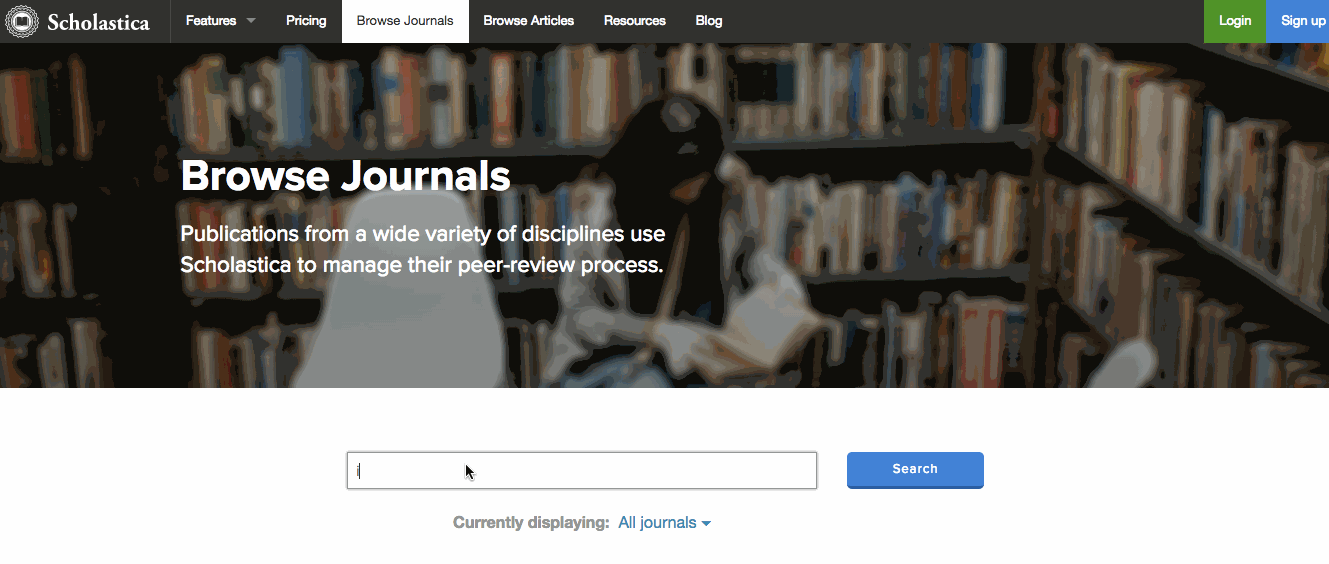
Once a scholar finds your open access journal, what can you do to encourage them to return to it?
Apart from the obvious and essential answer — publishing high-quality articles — you’ll need to focus on cultivating the journal’s online presence, starting with its website. Your journal’s website should be more than a storehouse for articles. It should offer a convenient and engaging content browsing experience and opportunities for readers to stay connected to your publication!
Let’s dive into five steps your publishing and editorial team can take to increase the chances of scholars returning to your OA journal website with examples from the Scholastica Open Access Publishing Platform.
Optimize your website for external search and on-site discovery

Of course, the first step to getting readers to frequent your OA journal website is attracting them to it, which requires optimizing your articles for external search, including via mainstream browsers like Google and Bing and academic search engines and indexes like Google Scholar and the Directory of Open Access Journals (DOAJ). If you’re in need of a comprehensive journal search engine optimization (SEO) guide, we encourage you to check out this blog post.
But your team shouldn’t stop at optimizing your content for external search engines. It’s also critical to prioritize on-site article discoverability so scholars can easily explore your journal website when they get to it. After all, you want new readers to look at additional pages beyond the ones they land on. And by offering a convenient article browsing experience, you can increase the chances of readers coming directly to your journal website in the future.
At the highest level, that starts with:
- Ensuring all pages of your journal website are mobile friendly
- Showcasing your latest content on your journal homepage (not just links to issues!)
- Organizing articles by categories that readers can easily click through to browse related works
A great approach to categorizing content is creating journal sections to separate articles by type, like the Psychotherapy and Counselling Journal of Australia (includes “Articles,” “Book Reviews,” “Editorials,” etc.) or by subject matter like Discrete Analysis, a mathematics journal with sections including, “Analytic Combinatorics,” “Dynamical Systems,” and “Functional Analysis.”
Both PCJA and Discrete Analysis host their websites via Scholastica. You can learn more about creating article sections for Scholastica journal websites in this help document (it just takes a couple of clicks!). When journals hosted via Scholastica tag articles with keywords, those also become clickable links, enabling readers to look at even more granular clusters or content with the same keyword.
Your journal website should also include at least a basic built-in search bar that readers can easily access from the top navigation and use to look for articles that contain desired keywords/phrases. Taking it a step further, you can also offer search refinement facets and filters to help readers narrow down results based on specific criteria.
For example, journal websites hosted via The Scholastica Open Access Publishing Platform include advanced on-site article search functionality that enables readers to apply any one or a combination of granular specifications to hone their search results, such as drilling down keyword searches to only display content published within a given date range and/or a particular journal section (as shown above).
Link your journal website to your social media accounts

If you want readers to keep coming back to your journal, you have to share updates about it in the online venues where they hang out! One of the best ways to do this is to post about your latest articles and publication news on social media. If your journal hasn’t entered the social media scene yet, now’s the time to start cultivating one or more social media accounts — and there are so many channels to choose from, including established platforms like LinkedIn and Facebook and emerging ones like Mastodon and Bluesky. You can learn more about which social media platforms offer the most engagement potential for scholarly journals here.
Once you have one or more journal social media channels set up, be sure to prominently feature them on your journal website so readers see that your journal is active on social media and can quickly follow your account(s). For example, journals that use Scholastica’s OA publishing platform can add links to LinkedIn, Facebook, and X (formerly Twitter) profiles to the top navigation of their website, like Precision Nanomedicine.
Start a journal blog so you frequently have fresh content to share
As you develop a social media following for your journal, you’ll want to ensure you frequently have fresh content to share with followers. One of the best ways to do this is starting a journal blog. Blogging offers the opportunity to regularly post journal updates and short-form content about timely topics in your field, in addition to articles and issues. It can also help boost the chances of your journal appearing higher on search engine results pages (SERPs) because browsers like Google and Google Scholar favor websites that frequently publish new content.
For example, The Open Journal of Astrophysics has a blog where they post about relevant topics like “Learned Societies and Equity in the Era of Open Access“ and where they share updates about the journal, including calls for papers and editorial process summary statistics.
You may be thinking, “I’m not sure our editors have time to write blog posts.” And that’s fair! The good news is they don’t necessarily have to. You can try crowd-sourcing content from your authors like the journals featured in this section of our “7 Examples of Great Digital Journal Promotion” blog post.
Journals using the Scholastica Open Access Publishing Platform should know it includes built-in blogging functionality!
Publish articles on a rolling basis
Another way to publish journal content more frequently is to make new articles available on a rolling basis (i.e., as they’re ready) instead of waiting to publish them in journal issues. For example, Survey Practice, the American Association for Public Opinion Research’s e-journal, publishes all articles as they’re accepted and then compiles them into issues by year for citation purposes retroactively.
As with blogging, when you publish on a rolling basis, you’ll have more frequent opportunities to share article announcements on social media and improve your overall website SEO. As readers learn that your journal publishes articles on a rolling basis, they may also become more likely to frequent it because they know they’ll be sure to find the latest research related to their field.
Set up a journal RSS feed

Finally, you can encourage readers to frequent your journal by adding an RSS feed to your website. Websites that offer RSS feeds create a feed file, typically in formats like RSS or Atom, which includes information about their latest content, such as article titles, summaries, publication dates, and links. Visitors can then subscribe to the journal feed using an RSS Reader application like Feedly to have it automatically display new entries from the website as content is published. RSS Readers allow users to aggregate and access the latest updates from multiple websites in one central location without having to visit each site individually. Offering this convenience can help your journal foster a loyal readership and increase the reach of your articles.
Creating a journal RSS feed doesn’t have to require technical setup on your part either — your hosting provider may be able to help! For example, Scholastica automatically generates RSS feeds for all journals that use our open access publishing platform and includes an RSS link in the top navigation of journal websites. When readers click the RSS icon on a Scholastica journal website, a popup appears with the journal’s RSS URL (as shown above) that visitors can paste into an RSS Reader. Scholastica journal website RSS feeds include new article and blog post updates with images and brief descriptions.
Wrapping it up
Developing a loyal journal readership starts with giving scholars a reason to frequent your website. By regularly publishing high-quality articles (and blog posts if possible!) and making it easy for readers to learn about your latest content and publication news, you can encourage them to visit your website more often and keep coming back.






![[Webinar on Demand] Digital law review publishing tools and tips: Scholastica overview](https://i.imgur.com/M49iGPkm.jpg)

